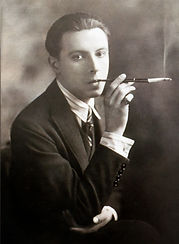Erté (Romain de Tirtoff)
1892-1990

Erté was brought up in St. Petersburg. In 1912 he went to Paris, where he briefly collaborated with Parisian couturier Paul Poiret. He then became a costume designer and began selling his pen-and-ink and gouache fashion illustrations to American fashion houses. From 1916 to 1937 he was under contract to the American fashion magazine Harper’s Bazaar. (A collection of Harper’s Bazaar illustrations was published in Designs by Erté [1976] with text by Stella Blum.) His highly stylized illustrations depicted models in mannered poses draped in luxurious jewels, feathers, and soft, flowing materials against a background of interiors in the Art Deco style. The same lavish style marked Erté’s theatrical designs. For 35 years he designed elaborately structured opening tableaus, finale scenes, and costumes for the French theatre. He worked for the Folies-Bergère in Paris from 1919 to 1930. In the 1960s Erté produced lithographs, serigraphs, and sheet-metal sculptures.



1988 23"(H) x 15"(W) Edition 203/375 Foundry stamp with stamp/chop mark
The impact of Erté’s contributions to the principles of contemporary fashion, design, and theater, and setting the visual pace within the 20th century, cannot be underestimated. His work set the precedent for the interconnection of art and culture. Erte art majestically encapsulates the taste and aesthetic of the time, with influences drawn from diverse sources such as Russian iconography, Byzantine mosaics, Greek pottery and Indian and Egyptian art.
Admired by celebrities of the time and emulated by the everyday woman, he is one of few artists who has had significant influence over cultural trends. Erté introduced the image of a stylized body draped in beads and furs, which would define and capture the essence of a generation: spectacle, exoticism, and fantasy. - Fiona McKay & Xenia Capacete
**Read the remainder of this article by clicking the Erté link**
